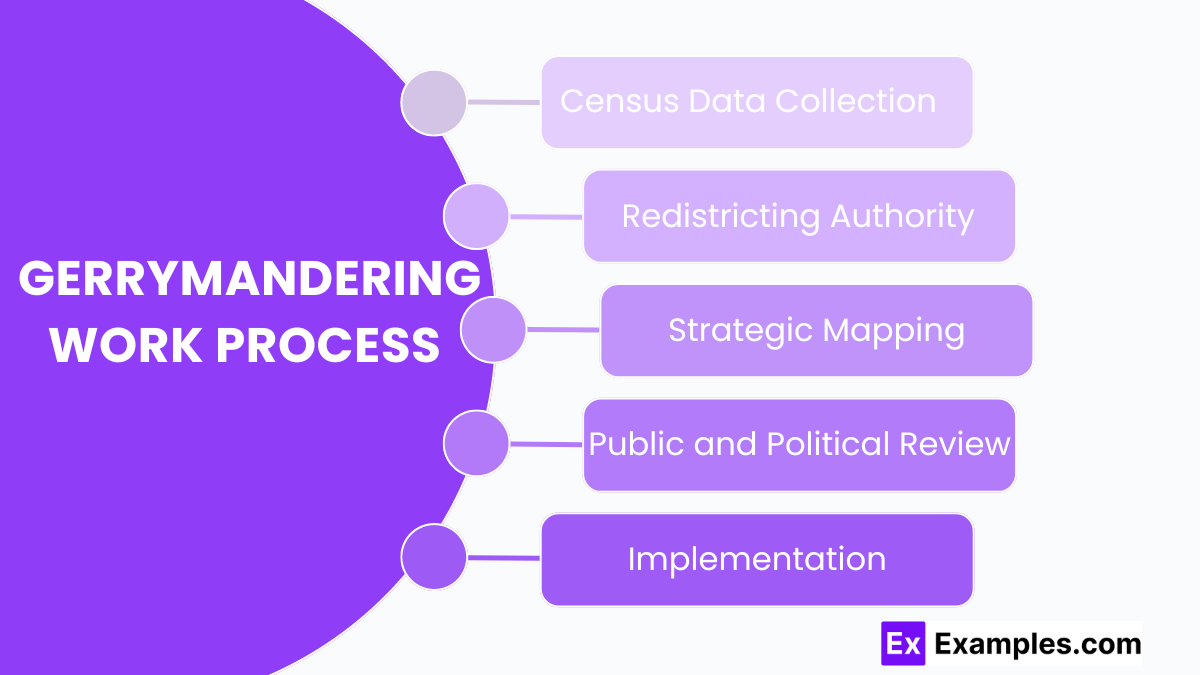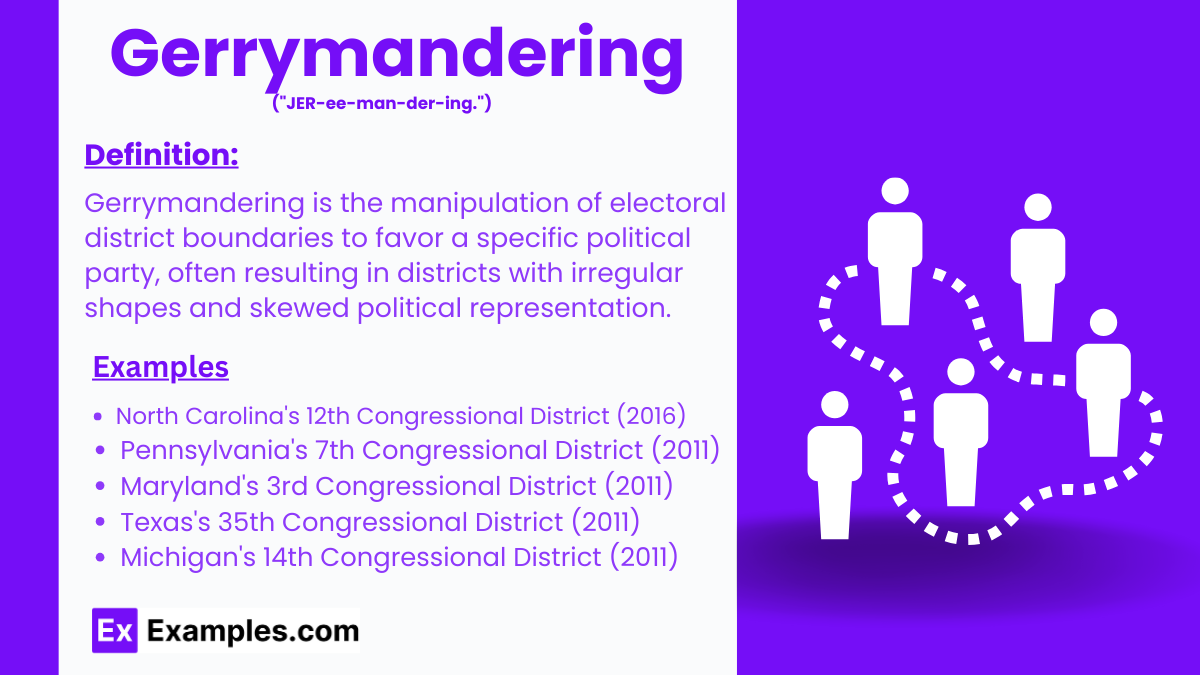21+ Gerrymandering Examples
Gerrymandering is the deliberate manipulation of electoral district boundaries to favor a specific political party or group. This practice often results in districts with convoluted, irregular shapes designed to increase the voting power of the dominant party while minimizing the influence of the opposition. The main idea behind gerrymandering is to secure electoral advantages, potentially undermining fair representation and democratic principles by creating imbalanced districts that do not reflect the true political landscape of the population.
What is Gerrymandering?
Gerrymandering is the manipulation of electoral district boundaries to benefit a particular political party. This practice creates districts with irregular shapes to enhance the voting strength of the favored party, often leading to unfair representation and a skewed political landscape.
Gerrymandering Examples
- North Carolina’s 12th Congressional District (2016)
- Pennsylvania’s 7th Congressional District (2011)
- Maryland’s 3rd Congressional District (2011)
- Texas’s 35th Congressional District (2011)
- Illinois’s 4th Congressional District (1992)
- Wisconsin’s State Assembly Districts (2011)
- Michigan’s 14th Congressional District (2011)
- Ohio’s 9th Congressional District (2011)
- Virginia’s 3rd Congressional District (1993)
- Georgia’s 13th Congressional District (2002)
- Florida’s 5th Congressional District (2012)
- Louisiana’s 2nd Congressional District (1993)
- Alabama’s 7th Congressional District (1992)
- Arizona’s 2nd Congressional District (2001)
- New York’s 10th Congressional District (2012)
- Indiana’s 4th Congressional District (2001)
- Kentucky’s 6th Congressional District (2011)
- Massachusetts’s 4th Congressional District (2012)
- Missouri’s 3rd Congressional District (2011)
- Nevada’s 4th Congressional District (2011)
- New Jersey’s 12th Congressional District (2012)
- South Carolina’s 6th Congressional District (1992)
- Tennessee’s 5th Congressional District (2001)
Functions
- Cracking – Dispersing voters of the opposing party across many districts to dilute their influence.
- Packing – Concentrating the opposing party’s voters in a few districts to reduce their influence elsewhere.
- Hijacking – Redrawing boundaries to force two incumbents from the opposing party into the same district.
- Kidnapping – Redrawing boundaries to move an incumbent’s home into a different district.
- Stacking – Merging districts in a way that favors one party over another.
- Bleaching – Redrawing boundaries to concentrate or dilute minority voters for electoral advantage.
Is Gerrymandering Legal?
- Understand Federal Law: Federal law does not outright ban gerrymandering but restricts it based on racial discrimination.
- Review Supreme Court Rulings: Key rulings, such as Shaw v. Reno and Rucho v. Common Cause, address racial and partisan gerrymandering.
- Examine State Laws: Some states have laws or independent commissions to prevent gerrymandering.
- Analyze Political Influence: Gerrymandering legality often hinges on the political context and specific court cases.
- Consider Public Opinion: Legal challenges frequently arise from public opposition to unfair practices.
- Monitor Changes: Legal standards for gerrymandering can evolve with new legislation and court decisions.
which party does the most gerrymandering?
Both major U.S. political parties, Republicans and Democrats, engage in gerrymandering when they control redistricting processes. The objective information shows that gerrymandering is used by the party in power at the state level to secure electoral advantages. The extent of gerrymandering often depends on which party holds the majority in state legislatures during redistricting.
Gerrymandering Work Process

- Census Data Collection: Every ten years, the U.S. Census collects population data, which determines how congressional districts are allocated.
- Redistricting Authority: State legislatures or independent commissions are responsible for redrawing district boundaries based on the new census data.
- Strategic Mapping: The controlling party manipulates district lines to favor their candidates, using tactics like “cracking” (splitting opposing voters) and “packing” (consolidating opposing voters).
- Public and Political Review: Proposed maps are reviewed, sometimes challenged, and can lead to political and legal battles.
- Implementation: Once approved, the new district boundaries are used in subsequent elections, often ensuring the dominant party retains or gains seats.
Racial Gerrymandering
Racial gerrymandering is the deliberate manipulation of electoral district boundaries to weaken the voting power of racial minority groups. Unlike self-care practices that promote well-being, racial gerrymandering can perpetuate inequality and undermine democratic principles. Similar to toxic masculinity, which enforces harmful norms, racial gerrymandering enforces unfair political advantages, often marginalizing minority communities and diminishing their electoral influence. This practice is a significant issue in ensuring fair representation in the democratic process.
Why is It Called Gerrymandering?
- Historical Origin: The term “gerrymandering” originated in 1812.
- Governor Elbridge Gerry: Massachusetts Governor Elbridge Gerry approved a redistricting plan that favored his party.
- The “Gerry-mander” Cartoon: A political cartoon depicted one of the oddly-shaped districts as a salamander, combining “Gerry” and “salamander” into “gerrymander.”
- Popularization: The term quickly gained popularity and was used to describe any manipulative redistricting.
- Enduring Term: Today, “gerrymandering” refers to the manipulation of electoral boundaries for political gain, maintaining its historical roots in Governor Gerry’s actions.
Does Gerrymandering Affect the Electoral College?
- Influence on House Elections: Gerrymandering directly affects congressional districts for the House of Representatives by manipulating boundaries to favor certain parties.
- Electoral Votes Distribution: The number of electoral votes each state has is partially based on the number of House representatives, which can be influenced by gerrymandered districts.
- State Legislatures’ Role: State legislatures, which may be shaped by gerrymandering, have the power to determine how electoral votes are allocated in some states.
- Indirect Impact: While gerrymandering does not change the total number of electoral votes, it can impact which party controls state legislatures and thus influence electoral outcomes indirectly.
Why is Gerrymandering a Problem?
- Undermines Fair Representation: Gerrymandering distorts electoral districts, making it difficult for elections to reflect the true will of the people.
- Reduces Electoral Competition: By creating “safe” districts for one party, gerrymandering reduces competition, leading to less accountable elected officials.
- Marginalizes Minority Groups: Gerrymandering often targets racial and political minorities, diluting their voting power and diminishing their influence in government.
- Polarizes Politics: By ensuring party dominance in certain districts, gerrymandering encourages extreme positions and reduces the incentive for politicians to appeal to a broad range of voters.
- Erodes Trust in Democracy: When voters perceive that district boundaries are manipulated for political gain, it undermines trust in the democratic process and institutions.
How Does Gerrymandering Impact Elections?
- Skews Representation: Gerrymandering manipulates district boundaries to favor one party, often resulting in disproportionate representation that doesn’t reflect the overall voting population.
- Reduces Competition: By creating safe seats for one party, gerrymandering discourages competitive elections, leading to unchallenged incumbents and less voter choice.
- Dilutes Minority Votes: It often concentrates or spreads out minority votes across districts to minimize their electoral impact, reducing their influence in elections.
- Promotes Extremism: Gerrymandered districts tend to be politically homogeneous, encouraging candidates to adopt more extreme positions to win primaries and general elections.
- Decreases Voter Turnout: When voters feel their influence is minimized due to manipulated districts, they are less likely to participate in elections, decreasing overall voter engagement and turnout.
How did gerrymandering get its name?
From Governor Elbridge Gerry and a district shaped like a salamander.
Is gerrymandering legal?
It is legal but subject to restrictions, especially against racial discrimination.
Who benefits from gerrymandering?
The political party in control of the redistricting process.
How does gerrymandering affect elections?
It skews representation, reduces competition, and can dilute minority votes.
Can gerrymandering be challenged in court?
Yes, especially if it violates constitutional or voting rights.
What are the main types of gerrymandering?
Partisan, racial, and bipartisan gerrymandering.
How often does redistricting occur?
Every ten years, following the U.S. Census.
What is “cracking” in gerrymandering?
Dividing a voting bloc across districts to dilute its power.
What is “packing” in gerrymandering?
Concentrating a voting bloc into one district to reduce its influence elsewhere.



